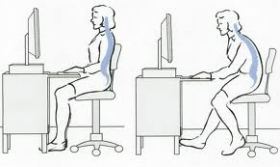A couple months ago my husband anxiously awaited the delivery of a stand to convert his traditional desk to a standing desk. As someone who hadn’t been tied to a desk for a few years I had a hard time understanding the purpose or even his excitement about making the change. I can honestly say given the option I would too have a standing desk.
Sitting all day makes me anxious, and in some ways, even though I’m clearly working, it makes me feel lazy. I work in a small office where I rarely need to get up to have a conversation with a co-worker and there are definitely no stairs involved in my day. The most activity I get is walking to the water cooler to refill my water bottle. By the time I leave the office I’ve accumulated a whopping 1,500 or so steps for the day.
I think it hit me the hardest when I was completing my profile for the MyFitnessPal app and selected ‘sedentary’ for my lifestyle. Ugh, I saw red flags flash before my eyes and heard warning sirens screaming through my head – personal trainer and group fitness instructor turns to a sedentary lifestyle.
Unfortunately, I’m not to the point that I feel comfortable asking for a standing desk. First, I’m still relatively new and with it being a small company there isn’t a whole lot of focus on providing customized desk set ups. In fact, I’m pretty sure most of the office chairs would fail ergonomic testing. Second, I’ve already proved myself as ‘which one of these things is not like the other.’ My co-workers think I’m a bit strange for ordering salads with no dressing when we go out to lunch and no one understands why I turn down the daily offerings of breads, pastries and other sweets.
While I don’t have the power to change my seating arrangement, I do have the ability to change my posture and activate my muscles while sitting. One of my favorite classes to teach is Pilates because it largely focuses on body awareness and activating muscles through proper posture. Pilates helps to build flexibility, muscle strength and endurance while developing a strong core. So why not apply the principles of the ‘Pilates posture’ to sitting at a desk?
Here’s how to do it (give it a try as you read through these cues):
Head: Elongate your spine and pull the top of your head towards the ceiling. You should feel taller.
Shoulders: Draw your shoulders down and away from your ears. You should also feel your chest open and your shoulders slightly tucked back so your shoulder blades are in contact with the back of your chair.
Core: Draw your navel up and in as though you are buttoning it to your spine. You should feel your abdominal muscles engage while your lower back presses lightly into the back of your chair.
Legs: Zip your legs together from your feet to your sacrum. You should feel your inner thighs (or adductors) engage.
Now granted, I understand this posture isn’t one that comes naturally. Believe me, I find myself with hunched shoulders, crossed legs and an overall droopy posture more than I would like to admit. However, now every time that I catch myself slouching I start from the top and work my way to my feet correcting my posture. It’s certainly not a full blown workout but maintaining these ‘connections’ makes my body do more work than if I was sitting here with no body awareness. For me it’s yet another good reminder that even the small things count when trying to maintain health.
Maybe after a while I will be comfortable enough in my own skin to stand at my desk, but until then I’ll continue with my seated Pilates workout.
